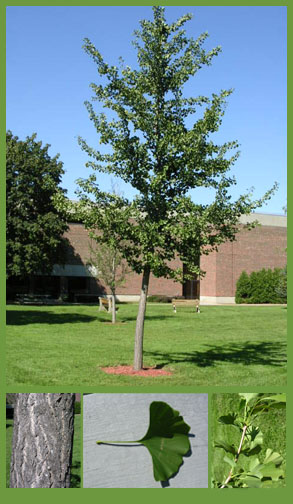Class: Ginkgoopisda
Order: Ginkgoales
Family: Ginkgoacea
Ginkgo biloba is a deciduous gymnosperm that prefers a sunny environment with moist, deep, and sandy soil but is capable of growing in stressful urban conditions. The Ginkgo trees can reach 30-40 meters in height and are sparsely branched with long and short branches. The trunk however becomes furrowed and ridged with age and gives rise to other trunks creating a spread of up to 8 meters creating it a well know shade tree. The leaves are a green fan-shape on the end of long petioles. The leaves occur in clusters at the ends of the shorter spur shoots or alternately on the terminal stems. During the fall the leaves turn brilliantly gold and typically all fall within in the span of a day.
The Ginkgo trees are either male or female depending on the production of sperm or the ovule. The male Ginkgo produces wind pollinated pollen with motile sperm that fertilize the females’ ovule (pseudo-fruits). These ‘fruits’ are delicious and contain a nut called Pak Ko, popular throughout Japan.
Fossil records show evidence of the Ginkgo from 270 million years ago during and is considered on of the world’s oldest existing tree species. The Ginkgo was once native in Asia, Europe and America during the Permian period (270mya) but its fossil record disappeared between 7-2.5mya everywhere except China and Japan. The Ginkgo was brought back to the United States in 1784 by William Hamilton and two tree are now located at Saint Michael’s College. Nicknamed the “living fossil” by Charles Darwin, the Ginkgo is virtually disease and pest free enabling it to survive many unfavorable conditions including the Hiroshima atomic bombing.
Ginkgo extracts have been used to improve and stabilize memory loss, Alzheimer’s disease, cardiovascular disease, cerebral vascular performance, and many other medical applications. Their leaves were even historically treasured and used to cure freckles.
Back |
 |